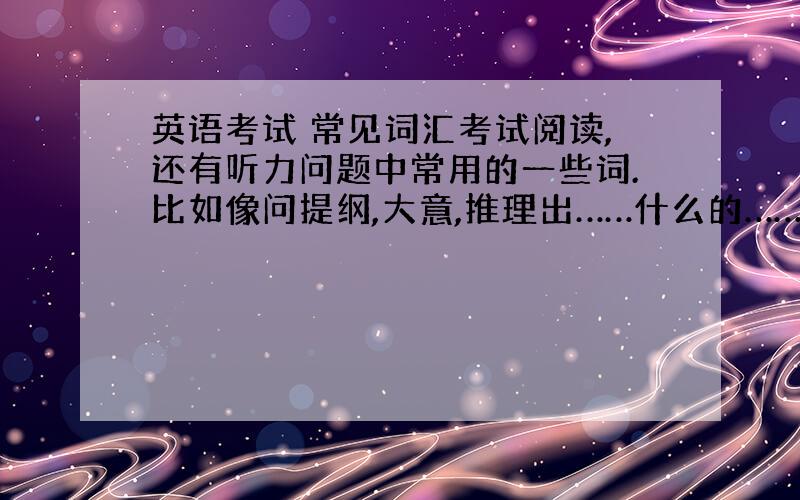英语考试 常见词汇考试阅读,还有听力问题中常用的一些词.比如像问提纲,大意,推理出……什么的……那些词.阅读!阅读!
来源:学生作业帮 编辑:大师作文网作业帮 分类:英语作业 时间:2024/11/18 03:51:48
英语考试 常见词汇
考试阅读,还有听力问题中常用的一些词.
比如像问提纲,大意,推理出……什么的……
那些词.
阅读!阅读!
考试阅读,还有听力问题中常用的一些词.
比如像问提纲,大意,推理出……什么的……
那些词.
阅读!阅读!

阅读理解题:
归纳概括主题
( Title and Main Idea )
归纳概括中心主旨的题目是高考必考题目,考查考生通过阅读理解,总结归纳,找出文章中心意思的能力.
要做好这类题考生必须区分主要信息和次要信息;既看到树木, 更看到森林;要跳出一词一句,而俯瞰全文;要通读全文,通篇理解.
找出主题句(topic sentence) 是一个有用的方法.
中心意思(main idea)通常是一个完整的句子,它应能全面准确地概括文章的中心主旨;最佳题目(the best title)可以是一个短语词组,它除能概括文章的中心主旨外,还有吸引读者,引发阅读兴趣的任务.
除常见的提问以外,这种题型的提问方式还有:
The main point of the passage is ...
The passage deals mainly with ...
The passage is about ...
What does the passage mainly discuss?
What is the author's main purpose ? ••• •••
领悟文章的隐含意义
(Hidden Meaning)
根据考试说明,高考阅读理解能力测试的第三点要求是:“既理解字面意思,也理解深层含义,包括作者的态度,意图等;”
由于某种原因,作者不能鲜明地表达自己的观点,而将其隐含在字里行间,流露于修辞手法之中.这类考题要求考生对于作者这种没有明确说明的写作目的,立场态度,思想倾向作出合理的推断.
读懂这种“言外之意,弦外之音”,要求考生有无障碍的阅读能力,“锣鼓听音”的敏锐感觉,合理推断的思维品质.这是阅读测试题中较难的类型,对考生的能力要求较高,需要认真训练.
这种题型的常用提问方式有:
The story does not say this, but from what we have read, we can tell that __________.
We can infer from the passage that __________.
The writer's attitude toward ... is __________.
The passage implies, but does not directly state that __________.
The passage suggests that __________.
We may conclude from the passage that __________.
推理判断
( Judgment, Logical Inference )
根据考试说明,高考阅读理解能力测试的第四点要求是:“能理解某句某段的意义,并能把握全篇文脉,即句与句,段与段的关系,并能据此进行推理和判断.”
这类考题旨在测试考生在阅读基础上的逻辑推理能力,要求考生根据文章所述事件的逻辑关系,对未说明的趋势或结局作出合理的推断;或根据作者所阐述的观点理论,对文章未涉及的现象,事例给以解释.
考生首先要仔细阅读短文,完整了解信息,准确把握作者观点.
在作出推理判断时,考生一定要依据短文内容或作者观点,切忌主观臆断,切忌以自己的观点看法取代作者的原意.
这种题型的常用提问方式有:
We can infer that __________.
It can be inferred from the passage that __________.
The passage implies that __________.
The passage suggests that __________.
It can be concluded from the passage that __________. ... ...
听力题:
高考考试的对话内容场景基本上都是考生所熟悉的,有校园、生活、工作、各种社交场所.了解一些场景下的常用语和常见表达对解题是很有帮助的.对这些常用词汇和短语不仅要知道其本身的意思,还要知道它们的同义表达方式.这是因为现在听力试题一般不会在选项中出现对话中的原词和词组.以下场景是对话当中所占比例最大的,掌握了这些场景下的常用短语和表达方式,也就从词汇和短语方面抓住了解题的关键.
(1)餐馆场景:
order 点菜 serve 上菜 change 零钱 Keep the change! 不用找零钱了! tip 小费 treat 请客 (This is my treat! 我请客!)go Dutch AA制 (Let’s go fifty fifty. ) steak 牛排 cheese奶酪 sandwich 三明治 bacon 腌肉 soup 汤 plain water 自来水(西餐中洗手用的)doughnut 多纳圈 appetizer 开胃物 dessert甜品,水果(作为正餐的最后一道) go out for dinner / dinner out 出去吃饭 snack bar 小吃街;大排挡 hamburger 汉堡包 coke 可口可乐 French fries 炸薯条 dining hall ;coffee shop ;restaurant ;cafeteria ;canteen; buffet 自助餐
(2)邮局场景:
stamp envelope package / parcel 包裹 overweight 超重 extra postage 额外邮资 send / post / deliver a letter / mail 寄 /发信 express mail 快件 airmail 航空信件 surface mail 陆地邮寄open an account 开一个帐户
(3)图书馆场景:
library card; borrow; lend; keep; renew; bookshelf; novel; science fiction科幻小说;magazine; periodical期刊; reference book; librarian 图书管理员 pay a fine 交罚款 Can I help you? / What can I do for you?
(4)医院及健康场景:
aspirin 阿司匹林 regular doctor 私人医生 emergence department 急诊室 ICU (= intensive care unit)特护病房 treatment 治疗手段 take one’s temperature / blood pressure 测量体温/血压 medicine: pills / tablets药丸/药片 heart attack 心脏病 cold / flu 流感:have/catch a cold; pain; headache; stomach-ache; backache; sore-throat喉咙痛 cough; fever.What’s up? (多用于男生之间)How is it going? How are you? 回答:I’m fine. / I feel good/terrific. / I couldn’t be better. / Nothing is very wrong with me. 好. I am not feeling good. / I feel terrible/horrible/awful. / I am not myself these days. 不好. (注意听语气:身体好的时候,语调上扬,语气非常欢快; 身体不好的时候,降调,语气非常郁闷.)
(5)电话场景:
operator 接线员 Extension six two two six, please. 请转6226. The line is bad/ busy / engaged. It kept a busy line. 电话占线.long distance call 长途电话 collect call 对方付费的电话 put through 接通电话 hold on / up Hold the line, please. Hello! This is …speaking. Who’s speaking? / who is this? call/ telephone/ ring/ phone sb. ;give sb. a call/ ring I’ll call back later / again. I’ll ring him / her up again. I couldn’t get through. Sorry, I’m afraid you have the wrong number.
请参考这个网址的听力
http://gaokao.tl100.com/200905/44161.shtml
归纳概括主题
( Title and Main Idea )
归纳概括中心主旨的题目是高考必考题目,考查考生通过阅读理解,总结归纳,找出文章中心意思的能力.
要做好这类题考生必须区分主要信息和次要信息;既看到树木, 更看到森林;要跳出一词一句,而俯瞰全文;要通读全文,通篇理解.
找出主题句(topic sentence) 是一个有用的方法.
中心意思(main idea)通常是一个完整的句子,它应能全面准确地概括文章的中心主旨;最佳题目(the best title)可以是一个短语词组,它除能概括文章的中心主旨外,还有吸引读者,引发阅读兴趣的任务.
除常见的提问以外,这种题型的提问方式还有:
The main point of the passage is ...
The passage deals mainly with ...
The passage is about ...
What does the passage mainly discuss?
What is the author's main purpose ? ••• •••
领悟文章的隐含意义
(Hidden Meaning)
根据考试说明,高考阅读理解能力测试的第三点要求是:“既理解字面意思,也理解深层含义,包括作者的态度,意图等;”
由于某种原因,作者不能鲜明地表达自己的观点,而将其隐含在字里行间,流露于修辞手法之中.这类考题要求考生对于作者这种没有明确说明的写作目的,立场态度,思想倾向作出合理的推断.
读懂这种“言外之意,弦外之音”,要求考生有无障碍的阅读能力,“锣鼓听音”的敏锐感觉,合理推断的思维品质.这是阅读测试题中较难的类型,对考生的能力要求较高,需要认真训练.
这种题型的常用提问方式有:
The story does not say this, but from what we have read, we can tell that __________.
We can infer from the passage that __________.
The writer's attitude toward ... is __________.
The passage implies, but does not directly state that __________.
The passage suggests that __________.
We may conclude from the passage that __________.
推理判断
( Judgment, Logical Inference )
根据考试说明,高考阅读理解能力测试的第四点要求是:“能理解某句某段的意义,并能把握全篇文脉,即句与句,段与段的关系,并能据此进行推理和判断.”
这类考题旨在测试考生在阅读基础上的逻辑推理能力,要求考生根据文章所述事件的逻辑关系,对未说明的趋势或结局作出合理的推断;或根据作者所阐述的观点理论,对文章未涉及的现象,事例给以解释.
考生首先要仔细阅读短文,完整了解信息,准确把握作者观点.
在作出推理判断时,考生一定要依据短文内容或作者观点,切忌主观臆断,切忌以自己的观点看法取代作者的原意.
这种题型的常用提问方式有:
We can infer that __________.
It can be inferred from the passage that __________.
The passage implies that __________.
The passage suggests that __________.
It can be concluded from the passage that __________. ... ...
听力题:
高考考试的对话内容场景基本上都是考生所熟悉的,有校园、生活、工作、各种社交场所.了解一些场景下的常用语和常见表达对解题是很有帮助的.对这些常用词汇和短语不仅要知道其本身的意思,还要知道它们的同义表达方式.这是因为现在听力试题一般不会在选项中出现对话中的原词和词组.以下场景是对话当中所占比例最大的,掌握了这些场景下的常用短语和表达方式,也就从词汇和短语方面抓住了解题的关键.
(1)餐馆场景:
order 点菜 serve 上菜 change 零钱 Keep the change! 不用找零钱了! tip 小费 treat 请客 (This is my treat! 我请客!)go Dutch AA制 (Let’s go fifty fifty. ) steak 牛排 cheese奶酪 sandwich 三明治 bacon 腌肉 soup 汤 plain water 自来水(西餐中洗手用的)doughnut 多纳圈 appetizer 开胃物 dessert甜品,水果(作为正餐的最后一道) go out for dinner / dinner out 出去吃饭 snack bar 小吃街;大排挡 hamburger 汉堡包 coke 可口可乐 French fries 炸薯条 dining hall ;coffee shop ;restaurant ;cafeteria ;canteen; buffet 自助餐
(2)邮局场景:
stamp envelope package / parcel 包裹 overweight 超重 extra postage 额外邮资 send / post / deliver a letter / mail 寄 /发信 express mail 快件 airmail 航空信件 surface mail 陆地邮寄open an account 开一个帐户
(3)图书馆场景:
library card; borrow; lend; keep; renew; bookshelf; novel; science fiction科幻小说;magazine; periodical期刊; reference book; librarian 图书管理员 pay a fine 交罚款 Can I help you? / What can I do for you?
(4)医院及健康场景:
aspirin 阿司匹林 regular doctor 私人医生 emergence department 急诊室 ICU (= intensive care unit)特护病房 treatment 治疗手段 take one’s temperature / blood pressure 测量体温/血压 medicine: pills / tablets药丸/药片 heart attack 心脏病 cold / flu 流感:have/catch a cold; pain; headache; stomach-ache; backache; sore-throat喉咙痛 cough; fever.What’s up? (多用于男生之间)How is it going? How are you? 回答:I’m fine. / I feel good/terrific. / I couldn’t be better. / Nothing is very wrong with me. 好. I am not feeling good. / I feel terrible/horrible/awful. / I am not myself these days. 不好. (注意听语气:身体好的时候,语调上扬,语气非常欢快; 身体不好的时候,降调,语气非常郁闷.)
(5)电话场景:
operator 接线员 Extension six two two six, please. 请转6226. The line is bad/ busy / engaged. It kept a busy line. 电话占线.long distance call 长途电话 collect call 对方付费的电话 put through 接通电话 hold on / up Hold the line, please. Hello! This is …speaking. Who’s speaking? / who is this? call/ telephone/ ring/ phone sb. ;give sb. a call/ ring I’ll call back later / again. I’ll ring him / her up again. I couldn’t get through. Sorry, I’m afraid you have the wrong number.
请参考这个网址的听力
http://gaokao.tl100.com/200905/44161.shtml
英语考试 常见词汇考试阅读,还有听力问题中常用的一些词.比如像问提纲,大意,推理出……什么的……那些词.阅读!阅读!
几类英语词英语阅读,理解中常用的词与时政相关的词,比如人名,地名什么的
考研英语阅读题问题中常见词汇有哪些?
高中英语阅读理解题中常见词汇
列举一些英语作文常用短语.比如In a word之类.阅读怎样提高…我现高三.做时总在选项中徘徊…
英语专四听力用上外陈汉生主编的,那别的呢(词汇、阅读…)还有套题呢,最好是上外的请大家推荐推荐
高中英语阅读理解中常见的课外词汇?
英语短文故事莪们班要英语演讲。就像考试的阅读一样。读完一篇文章就要回答问题。帮帮忙拉。帮莪弄一篇短文还有问几个问题就可以
关于雅思词汇书的问题还有1星期要考雅思,我看了十天突破雅思写作和口语,无词阅读法,但是写作和听力阅读的时候觉得单词词汇量
明天考英语六级,近几年翻译、阅读、听力等常见的词汇、词组,谁能给我个归纳.还有作文,发现词忘记太多了,从头到尾用重复的词
我想考托福,在纠结用什么资料复习词汇,阅读,听力,作文……
求高中英语阅读常见词汇